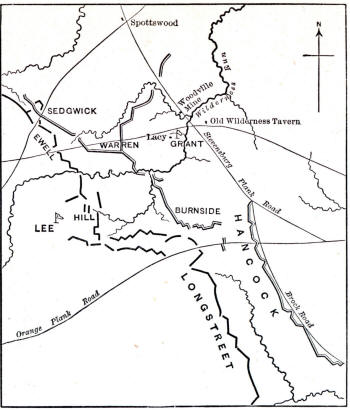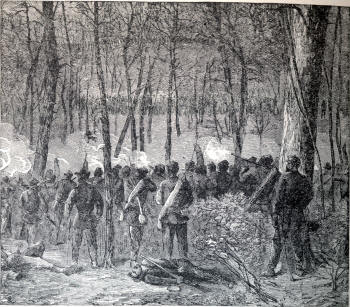|
Wilderness, BATTLE
OF THE. At midnight on May 3, 1864, the
Army of the Potomac,
fully 100,000 strong, fresh and hopeful, and with an immense army train,
began its march towards Richmond. The right was composed of the corps of
Warren and Sedgwick, and the left of that of
Hancock. Warren's cavalry,
preceded by that of Wilson, crossed the Rapidan at Germania Ford on the
morning of the 4th, followed by Sedgwick. The left, preceded by Gregg's
cavalry, and followed by the entire army train of wagons, 4,000 in number,
crossed at Ely's Ford at the same time.
Burnside's 9th Corps, left behind in
anticipation of a possible move of
Robert E. Lee on Washington, crossed the Rapidan and joined the army on
the 5th, when the whole force had pushed on into the region |

MAP OF THE WILDERNESS BATTLEFIELD
|
|
known as "The Wilderness," beyond
Chancellorsville, and well on the right flank of the Confederate army lying
behind strong entrenchments on Mine Run. The whole force of the National army was now
about 130,000 men, of whom a little more than 100,000 were available for
battle. When Lee discovered this movement he pushed forward nearly his whole
army to strike the flanks of the Nationals on their march. This movement
failed. On the 5th, Warren, who was followed by Sedgwick, sent the divisions
of Griffin and Crawford to make observations. The former was struck by
General Richard Ewell's corps, and the latter by
General A. P. Hill's a little later. The march was suspended. Crawford was withdrawn, and Griffin, reinforced by
Wadsworth's division, with Robinson's in support, soon defeated the advance
of confederate general
Richard Ewell; but, being continually reinforced, the Confederates soon defeated
the Nationals. It was now past noon. Grant was satisfied that
Robert E. Lee's troops
were near in full force. The country was so covered with shrub oaks, bushes,
and tangled vines that no observations could be made at any great distance.
Grant ordered up Sedgwick's corps to the support of Warren; while Hancock,
who was nearly 10 miles away, on the road to the left, marched back to join
Warren. Getty's division of Sedgwick's corps was posted at the junction of
two roads, with orders to hold the position at all hazards until the arrival
of Hancock. The fighting, where it was begun in the morning, continued
fierce until 4 P.M., when both armies fell back and entrenched within 200
yards of each other. Getty held his ground against severe pressure by
A. P. Hill
until Hancock's advance reached him at three o'clock.

BATTLE OF THE WILDERNESS.
He then made an aggressive movement, and fighting was kept up until dark,
with heavy losses on both sides. Burnside's corps was brought up in the
night and placed between Hancock and Warren.
Meanwhile General Robert E. Lee brought up
General James Longstreet's corps to the support of
A. P. Hill. And now
each party in the contest was strengthened by an addition of 20,000 men.
Just before 5 A.M. Ewell attacked the National right, and was repulsed. A
very little later Hancock advanced his force against the Confederate right;
while Wadsworth, who had prepared to strike Hill's left the night before,
assailed him heavily. The Confederates were driven back a mile and a half,
passing Lee's headquarters in the retreat. The flight was checked by
James Longstreet's advancing column. Hancock, expecting to be assailed by
Longstreet, had attacked with only half
his force. The latter's advance having been checked, he resumed his flank
movement; but at that moment he was wounded and carried from the field, and his command devolved on Gen. R.
H. Anderson. In the afternoon Robert E. Lee projected the entire corps of
Longstreet
and Hill against Hancock, who had been reinforced and was strongly defended
by breastworks. He stood firm until about four o'clock, when a fire in the
woods attacked the brush and pine logs of his breastworks. The wind blew the
heat and smoke in the faces of his troops and drove them from their
defenses, when the Confederates dashed forward and penetrated their lines.
But they were almost instantly repulsed, and
Lee was compelled to abandon
what he intended as a decisive assault. Night came on, and after dark
Lee
threw Ewell's corps forward against Sedgwick. There was some hard fighting
and much confusion. Confederate General
Richard Ewell captured
the most of two brigades, and then fell back. So ended the battle in the
Wilderness, without decisive results on either side, and with a mutually
heavy loss. In the two days the Nationals lost about 18,000 men, of whom
6,000 were made prisoners. Generals Hays, Wadsworth, and Webb were killed.
Longstreet's
wounds disabled him for several months. The Wilderness is a wild plateau,
covered with a dense growth of dwarf trees and vines and brambles, and
sloping every way to cultivated fields. It is along the south bank of the
Rapidan River, about 10 miles in width and 15 in length. |

